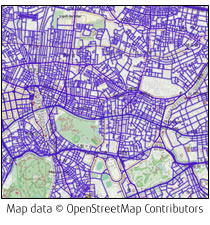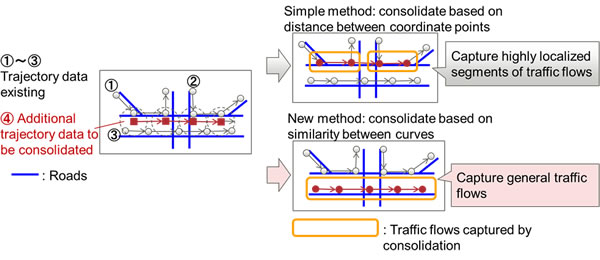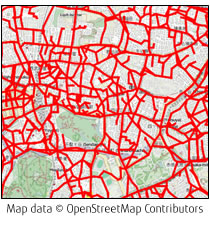Kawasaki, Japan, May 07, 2014
Fujitsu Laboratories Ltd. has developed trajectory-analysis technology that enables a big picture view of person and vehicle flows by putting trajectory data measured using GPS and other means into a form suitable for analysis.
The trajectory analysis used in the transport field is typically conducted by analyzing all the coordinate points contained in the trajectory data matched to roads plotted on a map, with that analyzed as the travel route. However, the issue with this method is that the traffic flows will appear segmented when road data is excessively detailed.
Fujitsu Laboratories has developed a technology that consolidates trajectory data based on similarity, taking into account the shape of trajectories. By creating route graphs that show the overall flow of persons and vehicles, it is possible to analyze a big picture view of traffic flows, such as route analysis, without using road data. This technology holds the promise of quickly forecasting points of congestion when a road is blocked, and of analyzing the flows of persons through large-scale theme parks, for which road maps do not exist, as well as the paths of aircraft and watercraft.
This technology will be exhibited at Fujitsu Forum 2014, May 15-16 at the Tokyo International Forum in Tokyo.
Background
The spread of GPS and public wireless networks have made it possible to inexpensively collect positional data from persons and vehicles in motion. Trajectory data, which is a time series of positional data, is the subject of considerable interest, as it has widespread uses in urban planning, transport policy, and marketing, to improve public services or business competitiveness. In particular, origin destination (OD) analysis, which aggregates only departure points and arrival points, and path analysis, which also aggregates the routes travelled, have led to a demand for a trajectory-analysis technology that offers a big picture view of person and vehicle flows, and that can be used to recommend destinations or predict travel times.
Issues

Figure 1: Road data
A typical approach to trajectory analysis in transport planning is to match all of the coordinate points included in the trajectory data to road data, and to interpret the path travelled on the road (Figure 1). Major cities already have digital road data with intersections and other branching points represented as nodes, and streets that run between multiple nodes are represented as links.
Each coordinate point contained in a set of trajectory data is matched to the nearest link or node, which simplifies the basic process of counting the number of vehicles traversing any route. But when road data is excessively detailed, with intervals a few dozen meters apart, it becomes easier to extract brief segments of the traffic flows in isolation, but more difficult to discern the overall traffic flow. Moreover, the timing of GPS coordinate positioning is not limited only to nodes, making it difficult to prioritize a road from rough trajectory data when there are multiple candidate roads that match such data.
About the Technology
Fujitsu Laboratories has developed a preprocessing technology for trajectory data analysis that automatically generates a route graph where trajectory data has been simplified (Figure 2). The route graph gives a complete overview that makes it possible to comprehend the general flows of persons and vehicles.
Features of the technology are as follows.
1. Consolidates similar trajectory data
This technology generates route graphs with simplified trajectory data by consolidating similar trajectory data based on the similarity of curves (Figure 3). Simply consolidating based on the distance between coordinate points in trajectory data is liable to result in consolidating highly localized segments, but this would sacrifice the ability to capture the general flows of traffic. By treating trajectory data as curves and consolidating similar curves, it is possible to capture and extract the general flows of traffic from similar trajectory data.

Figure 2: Consolidating trajectory data

Figure 3: Route graph
2. Trajectory analysis with no road data
This technology consolidates trajectory data using a clear index, which is the similarity between curves. It therefore has no relationship to road data and it completely sidesteps the problem of prioritizing a road. So preprocessing and trajectory analysis are almost completely unaffected by changes to the road network. Furthermore, because this technique does not use road data, it is possible to freely set the degree of consolidation granularity.
Results
This technology can quickly discover detours that people use for city marathons or other major road-closure events, and can be used to set suggested travel routes in advance or reflect them in guidance plans. Furthermore, because it does not use road data, it can be applied in contexts where there are no road maps in order to analyze the flows of persons, such as in a large-scale theme park, or aircraft and watercraft routes.
Future Plans
Fujitsu Laboratories is currently conducting practical trials of this technology with the goal of incorporating it into a commercial product during fiscal 2014.
![]() E-mail: spatiotemporal@ml.labs.fujitsu.com
E-mail: spatiotemporal@ml.labs.fujitsu.com

